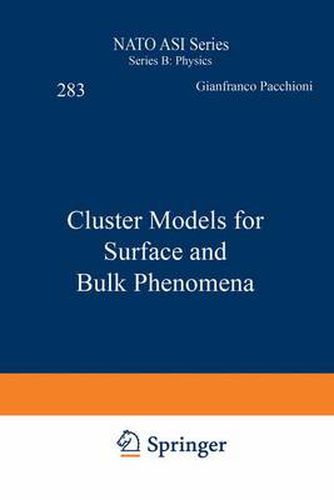Readings Newsletter
Become a Readings Member to make your shopping experience even easier.
Sign in or sign up for free!
You’re not far away from qualifying for FREE standard shipping within Australia
You’ve qualified for FREE standard shipping within Australia
The cart is loading…






It is widely recognized that an understanding of the physical and chemical properties of clusters will give a great deal of important information relevant to surface and bulk properties of condensed matter. This relevance of clusters for condensed matter is one of the major motivations for the study of atomic and molecular clusters. The changes of properties with cluster size, from small clusters containing only a few atoms to large clusters containing tens of thousands of atoms, provides a unique way to understand and to control the development of bulk properties as separated units are brought together to form an extended system. Another important use of clusters is as theoretical models of surfaces and bulk materials. The electronic wavefunctions for these cluster models have special advantages for understanding, in particular, the local properties of condensed matter. The cluster wavefunctions, obtained with molecular orbital theory, make it possible to relate chemical concepts developed to describe chemical bonds in molecules to the very closely related chemical bonding at the surface and in the bulk of condensed matter. The applications of clusters to phenomena in condensed matter is a cross-disciplinary activity which requires the interaction and collaboration of researchers in traditionally separate areas. For example, it is necessary to bring together workers whose background and expertise is molecular chemistry with those whose background is solid state physics. It is also necessary to bring together experimentalists and theoreticians.
$9.00 standard shipping within Australia
FREE standard shipping within Australia for orders over $100.00
Express & International shipping calculated at checkout
It is widely recognized that an understanding of the physical and chemical properties of clusters will give a great deal of important information relevant to surface and bulk properties of condensed matter. This relevance of clusters for condensed matter is one of the major motivations for the study of atomic and molecular clusters. The changes of properties with cluster size, from small clusters containing only a few atoms to large clusters containing tens of thousands of atoms, provides a unique way to understand and to control the development of bulk properties as separated units are brought together to form an extended system. Another important use of clusters is as theoretical models of surfaces and bulk materials. The electronic wavefunctions for these cluster models have special advantages for understanding, in particular, the local properties of condensed matter. The cluster wavefunctions, obtained with molecular orbital theory, make it possible to relate chemical concepts developed to describe chemical bonds in molecules to the very closely related chemical bonding at the surface and in the bulk of condensed matter. The applications of clusters to phenomena in condensed matter is a cross-disciplinary activity which requires the interaction and collaboration of researchers in traditionally separate areas. For example, it is necessary to bring together workers whose background and expertise is molecular chemistry with those whose background is solid state physics. It is also necessary to bring together experimentalists and theoreticians.